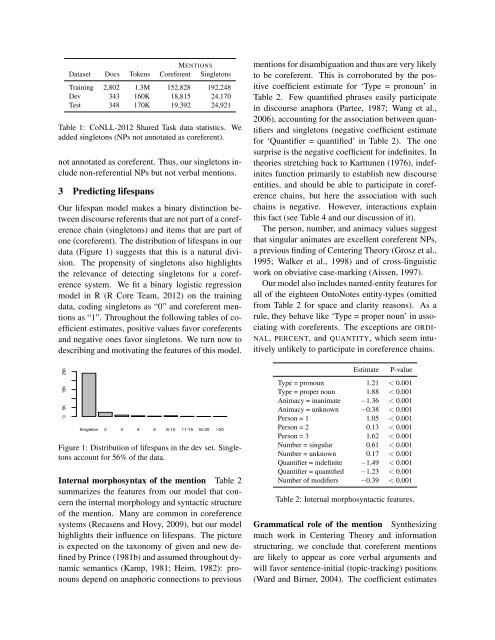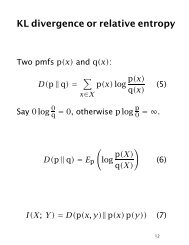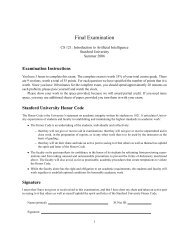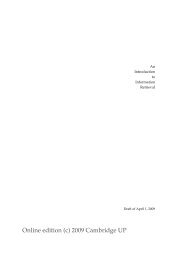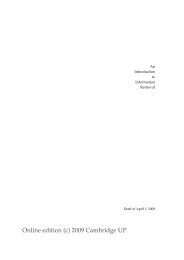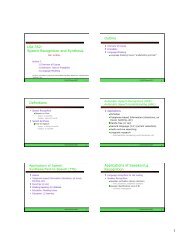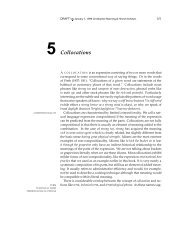The Life and Death of Discourse Entities: Identifying Singleton ...
The Life and Death of Discourse Entities: Identifying Singleton ...
The Life and Death of Discourse Entities: Identifying Singleton ...
You also want an ePaper? Increase the reach of your titles
YUMPU automatically turns print PDFs into web optimized ePapers that Google loves.
MENTIONS<br />
Dataset Docs Tokens Coreferent <strong>Singleton</strong>s<br />
Training 2,802 1.3M 152,828 192,248<br />
Dev 343 160K 18,815 24,170<br />
Test 348 170K 19,392 24,921<br />
Table 1: CoNLL-2012 Shared Task data statistics. We<br />
added singletons (NPs not annotated as coreferent).<br />
not annotated as coreferent. Thus, our singletons include<br />
non-referential NPs but not verbal mentions.<br />
3 Predicting lifespans<br />
Our lifespan model makes a binary distinction between<br />
discourse referents that are not part <strong>of</strong> a coreference<br />
chain (singletons) <strong>and</strong> items that are part <strong>of</strong><br />
one (coreferent). <strong>The</strong> distribution <strong>of</strong> lifespans in our<br />
data (Figure 1) suggests that this is a natural division.<br />
<strong>The</strong> propensity <strong>of</strong> singletons also highlights<br />
the relevance <strong>of</strong> detecting singletons for a coreference<br />
system. We fit a binary logistic regression<br />
model in R (R Core Team, 2012) on the training<br />
data, coding singletons as “0” <strong>and</strong> coreferent mentions<br />
as “1”. Throughout the following tables <strong>of</strong> coefficient<br />
estimates, positive values favor coreferents<br />
<strong>and</strong> negative ones favor singletons. We turn now to<br />
describing <strong>and</strong> motivating the features <strong>of</strong> this model.<br />
0 5K 15K 25K<br />
<strong>Singleton</strong> 2 3 4 5 6-10 11-15 16-20 >20<br />
Figure 1: Distribution <strong>of</strong> lifespans in the dev set. <strong>Singleton</strong>s<br />
account for 56% <strong>of</strong> the data.<br />
Internal morphosyntax <strong>of</strong> the mention Table 2<br />
summarizes the features from our model that concern<br />
the internal morphology <strong>and</strong> syntactic structure<br />
<strong>of</strong> the mention. Many are common in coreference<br />
systems (Recasens <strong>and</strong> Hovy, 2009), but our model<br />
highlights their influence on lifespans. <strong>The</strong> picture<br />
is expected on the taxonomy <strong>of</strong> given <strong>and</strong> new defined<br />
by Prince (1981b) <strong>and</strong> assumed throughout dynamic<br />
semantics (Kamp, 1981; Heim, 1982): pronouns<br />
depend on anaphoric connections to previous<br />
mentions for disambiguation <strong>and</strong> thus are very likely<br />
to be coreferent. This is corroborated by the positive<br />
coefficient estimate for ‘Type = pronoun’ in<br />
Table 2. Few quantified phrases easily participate<br />
in discourse anaphora (Partee, 1987; Wang et al.,<br />
2006), accounting for the association between quantifiers<br />
<strong>and</strong> singletons (negative coefficient estimate<br />
for ‘Quantifier = quantified’ in Table 2). <strong>The</strong> one<br />
surprise is the negative coefficient for indefinites. In<br />
theories stretching back to Karttunen (1976), indefinites<br />
function primarily to establish new discourse<br />
entities, <strong>and</strong> should be able to participate in coreference<br />
chains, but here the association with such<br />
chains is negative. However, interactions explain<br />
this fact (see Table 4 <strong>and</strong> our discussion <strong>of</strong> it).<br />
<strong>The</strong> person, number, <strong>and</strong> animacy values suggest<br />
that singular animates are excellent coreferent NPs,<br />
a previous finding <strong>of</strong> Centering <strong>The</strong>ory (Grosz et al.,<br />
1995; Walker et al., 1998) <strong>and</strong> <strong>of</strong> cross-linguistic<br />
work on obviative case-marking (Aissen, 1997).<br />
Our model also includes named-entity features for<br />
all <strong>of</strong> the eighteen OntoNotes entity-types (omitted<br />
from Table 2 for space <strong>and</strong> clarity reasons). As a<br />
rule, they behave like ‘Type = proper noun’ in associating<br />
with coreferents. <strong>The</strong> exceptions are ORDI-<br />
NAL, PERCENT, <strong>and</strong> QUANTITY, which seem intuitively<br />
unlikely to participate in coreference chains.<br />
Estimate P-value<br />
Type = pronoun 1.21 < 0.001<br />
Type = proper noun 1.88 < 0.001<br />
Animacy = inanimate −1.36 < 0.001<br />
Animacy = unknown −0.38 < 0.001<br />
Person = 1 1.05 < 0.001<br />
Person = 2 0.13 < 0.001<br />
Person = 3 1.62 < 0.001<br />
Number = singular 0.61 < 0.001<br />
Number = unknown 0.17 < 0.001<br />
Quantifier = indefinite −1.49 < 0.001<br />
Quantifier = quantified −1.23 < 0.001<br />
Number <strong>of</strong> modifiers −0.39 < 0.001<br />
Table 2: Internal morphosyntactic features.<br />
Grammatical role <strong>of</strong> the mention Synthesizing<br />
much work in Centering <strong>The</strong>ory <strong>and</strong> information<br />
structuring, we conclude that coreferent mentions<br />
are likely to appear as core verbal arguments <strong>and</strong><br />
will favor sentence-initial (topic-tracking) positions<br />
(Ward <strong>and</strong> Birner, 2004). <strong>The</strong> coefficient estimates


